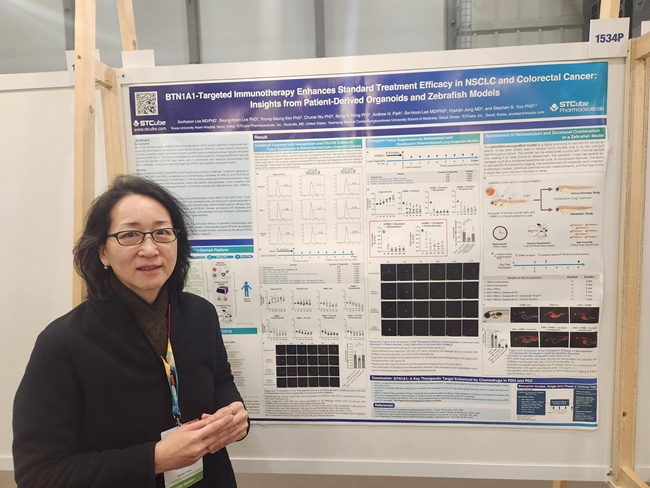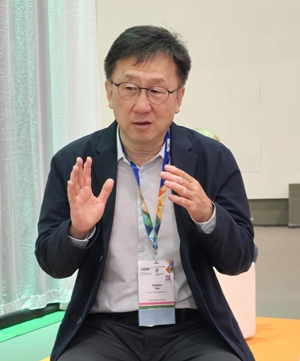- BTN1A1 effective in PD-L1–negative, resistant tumors
- by Hwang, byoung woo | translator Alice Kang | Oct 23, 2025 06:12am
The company has been exploring therapeutic responses of its first-in-class BTN1A1-targeting drug candidate, Nelmastobart, in patients with PD-L1–negative or PD-1-resistant tumors, marking the first step toward realizing precision immunotherapy.
At the European Society for Medical Oncology (ESMO) 2025 Congress, STCube presented two studies: an investigator-initiated trial and a preclinical study. The investigator-initiated trial demonstrated a correlation between BTN1A1 expression levels and progression-free survival, while the preclinical study showed the complementary effect of BTN1A1 inhibition when combined with chemotherapy.
Dailypharm met with Seung-han Yoo, Chief Scientific Officer (CSO) of STCube, and Soo-hyeon Lee, Professor of Medical Oncology at Korea University Anam Hospital, in Berlin to discuss the significance of the research and future plans.

“Efficacy observed in PD-L1–negative patients, new potential found for precision immunotherapy”
According to the company, BTN1A1 is a target first identified globally by STCube and is an immune checkpoint protein that acts independently of PD-L1.
BTN1A1 shows minimal expression in normal tissues but high expression in tumor cells, making it both a therapeutic target and a potential predictive biomarker.
CSO Yoo explained, “BTN1A1 is highly expressed in tumors where PD-L1 is rarely expressed, particularly colorectal cancer and non-small cell lung cancers. It has the potential to open a new response pathway in patient groups unresponsive to existing immune checkpoint inhibitors.”
The ESMO presentation featured interim analysis results from an ongoing Phase 1b/2 investigator-initiated clinical trial for metastatic colorectal cancer at Korea University Anam Hospital, focusing on differences in progression-free survival by degree of BTN1A1 expression.
The preclinical poster confirmed that BTN1A1 expression actually increases after chemotherapy.
CSO Yoo stated, “Unlike how PD-L1 is primarily expressed in rapidly growing tumor cells, BTN1A1 is highly expressed in slow-growing cells that remain after treatment—specifically, dormant tumor cells. This allows for a complementary effect when combined with chemotherapy.”
He added, “In the study, tumor suppression was significantly enhanced when BTN1A1 inhibitors were co-administered with standard anticancer drugs like FOLFOX (folinic acid + fluorouracil + oxaliplatin) and FOLFIRI (folinic acid + fluorouracil + irinotecan) for colorectal cancer, FOLFIRI for lung cancer, and docetaxel for lung cancer. The findings suggest we could consider adopting a combination strategy for patients resistant to PD-1 inhibitors.”
“Extends revival in BTN1A1-High patients... will acclerate biomarker clinical trials”
A correlation between BTN1A1 expression levels and clinical response was also observed in the ongoing colorectal cancer investigator-initiated clinical trial (Phase 1b/2) at Korea University Anam Hospital.

These results represent an improvement over the average 2-3 months seen with existing standard third-line therapies. Based on this, the company is actively advancing its biomarker-based clinical strategy targeting BTN1A1-positive patients and is preparing to initiate dosing in its company-led Phase II trial for non-small cell lung cancer by the end of this year.
On this day, Professor Lee summarized the clinical significance of the BTN1A1 inhibitor into four points, in addition to the explanation provided by CSO Yoo.
“It presents new possibilities for cancer types unresponsive to existing PD-1-centric therapies and can serve as a combination partner for PD-1-resistant or refractory patients. Alongside the significance of biomarker-based clinical design, its minimal toxicity when combined positions it to evolve into a safe immuno-oncology platform.”
Professor Lee further evaluated, “While PD-1 combination therapy can sometimes cause unexpected immune-related adverse reactions, BTN1A1 inhibitors do not add toxicity when combined with existing drugs. In fact, their high safety profile makes them suitable as new combination partners.”
Lee added that no immune-related adverse reactions were reported in actual patient administration, but noted that confirming long-term and large-scale safety remains a subsequent task.
“Will build data and explore global collaboration… to realize precision immunotherapy”
The company plans to use these results as clinical evidence for its BTN1A1-based precision immunotherapy platform and accelerate the expansion of its subsequent pipeline.
Specifically, it intends to secure additional clinical data for colorectal and lung cancer by early next year and then formally initiate technology transfer discussions with global pharmaceutical companies.
In the long term, the strategy is to build a precision immunotherapy portfolio centered on BTN1A1 inhibitors to address unmet needs in the post-PD-1 market.
CSO Yoo added, “BTN1A1 could be the missing link explaining immune responses not accounted for by PD-L1. We will work step-by-step to demonstrate the potential of precision immuno-oncology through clinical data.”
-

- 0
댓글 운영방식은
댓글은 실명게재와 익명게재 방식이 있으며, 실명은 이름과 아이디가 노출됩니다. 익명은 필명으로 등록 가능하며, 대댓글은 익명으로 등록 가능합니다.
댓글 노출방식은
댓글 명예자문위원(팜-코니언-필기모양 아이콘)으로 위촉된 데일리팜 회원의 댓글은 ‘게시판형 보기’와 ’펼쳐보기형’ 리스트에서 항상 최상단에 노출됩니다. 새로운 댓글을 올리는 일반회원은 ‘게시판형’과 ‘펼쳐보기형’ 모두 팜코니언 회원이 쓴 댓글의 하단에 실시간 노출됩니다.
댓글의 삭제 기준은
다음의 경우 사전 통보없이 삭제하고 아이디 이용정지 또는 영구 가입제한이 될 수도 있습니다.
-
저작권·인격권 등 타인의 권리를 침해하는 경우
상용 프로그램의 등록과 게재, 배포를 안내하는 게시물
타인 또는 제3자의 저작권 및 기타 권리를 침해한 내용을 담은 게시물
-
근거 없는 비방·명예를 훼손하는 게시물
특정 이용자 및 개인에 대한 인신 공격적인 내용의 글 및 직접적인 욕설이 사용된 경우
특정 지역 및 종교간의 감정대립을 조장하는 내용
사실 확인이 안된 소문을 유포 시키는 경우
욕설과 비어, 속어를 담은 내용
정당법 및 공직선거법, 관계 법령에 저촉되는 경우(선관위 요청 시 즉시 삭제)
특정 지역이나 단체를 비하하는 경우
특정인의 명예를 훼손하여 해당인이 삭제를 요청하는 경우
특정인의 개인정보(주민등록번호, 전화, 상세주소 등)를 무단으로 게시하는 경우
타인의 ID 혹은 닉네임을 도용하는 경우
-
게시판 특성상 제한되는 내용
서비스 주제와 맞지 않는 내용의 글을 게재한 경우
동일 내용의 연속 게재 및 여러 기사에 중복 게재한 경우
부분적으로 변경하여 반복 게재하는 경우도 포함
제목과 관련 없는 내용의 게시물, 제목과 본문이 무관한 경우
돈벌기 및 직·간접 상업적 목적의 내용이 포함된 게시물
게시물 읽기 유도 등을 위해 내용과 무관한 제목을 사용한 경우
-
수사기관 등의 공식적인 요청이 있는 경우
-
기타사항
각 서비스의 필요성에 따라 미리 공지한 경우
기타 법률에 저촉되는 정보 게재를 목적으로 할 경우
기타 원만한 운영을 위해 운영자가 필요하다고 판단되는 내용
-
사실 관계 확인 후 삭제
저작권자로부터 허락받지 않은 내용을 무단 게재, 복제, 배포하는 경우
타인의 초상권을 침해하거나 개인정보를 유출하는 경우
당사에 제공한 이용자의 정보가 허위인 경우 (타인의 ID, 비밀번호 도용 등)
※이상의 내용중 일부 사항에 적용될 경우 이용약관 및 관련 법률에 의해 제재를 받으실 수도 있으며, 민·형사상 처벌을 받을 수도 있습니다.
※위에 명시되지 않은 내용이더라도 불법적인 내용으로 판단되거나 데일리팜 서비스에 바람직하지 않다고 판단되는 경우는 선 조치 이후 본 관리 기준을 수정 공시하겠습니다.
※기타 문의 사항은 데일리팜 운영자에게 연락주십시오. 메일 주소는 dailypharm@dailypharm.com입니다.
- [Op-Ed] Patients, no time left for 'new drug comb therapies'
- Special Contribution | Eo, Yun-Ho









